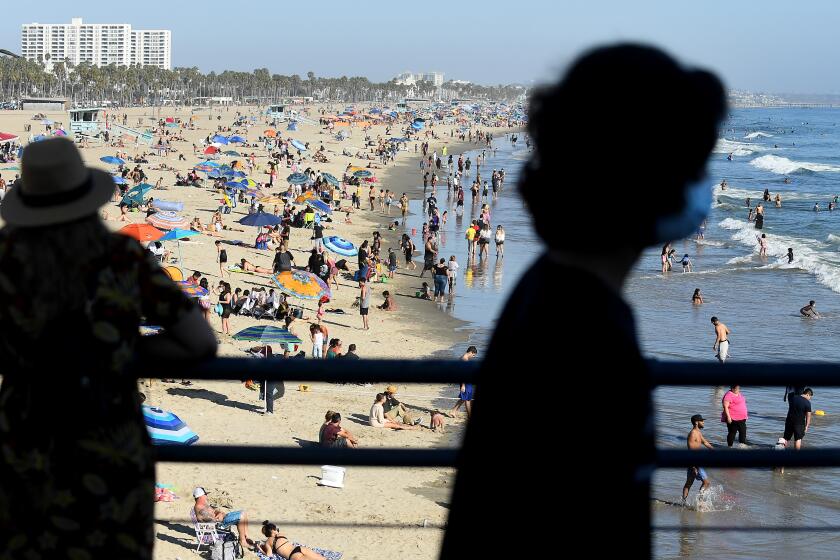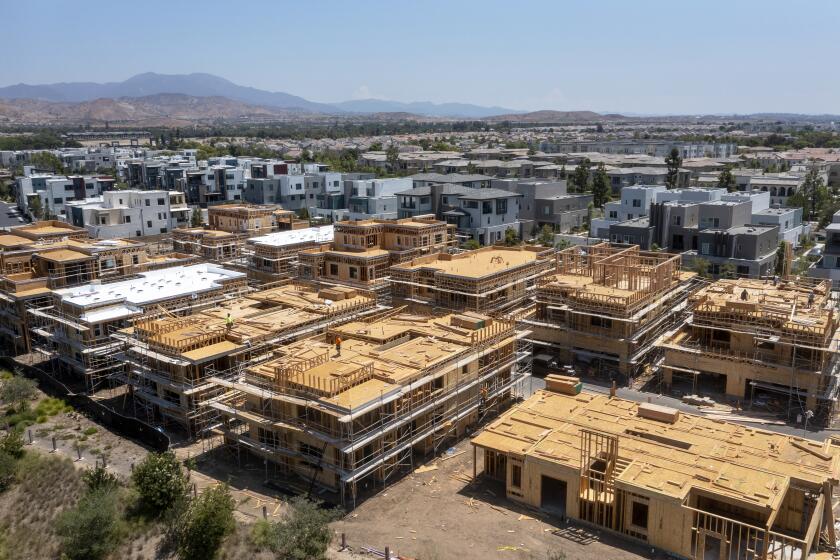Californians move inland for safety, cheaper housing — but find extreme heat that’s getting worse

- Share via
Sharon Daniels, 66, had lived in Antioch since 1984.
But, growing concerned about crime, she and her husband decided it was time to move away from the East Bay and its delta breezes to a more affordable, far-flung community in the San Joaquin Valley.
She and her husband, Anthony, saw ads for new developments in the city of Lathrop in San Joaquin County, where they could build a new home for the same price as buying an existing one in Antioch. The median home in Lathrop sold for $530,400 in June 2023, compared with $930,000 in Antioch’s Contra Costa County, according to the California Assn. of Realtors.
The couple recently built a home in Lathrop, which keeps them within about a 30-minute drive of their daughter and grandchildren in the Bay Area.
“I feel very safe here. No more police chases and sirens at night,” she said, citing a drive-by shooting on their block as a key reason they left Antioch. “For us it’s a win.”
Except for one thing.
“It’s significantly hotter out here,” she said.
L.A. County could have 1.7 million fewer people by 2060. It’s not only because residents are leaving
The state population is expected to be flat over the coming decades for the first time in California history. See which counties will gain and lose people.
As with most communities in California, the stark difference in home prices between the Danielses’ former and current counties of residence is inversely related to the climate: The hotter a region is, the more affordable housing is.
Contra Costa County — home to Antioch — will have 71 days of extreme heat annually on average between 2035 and 2064, according to projections in the California Healthy Places Index: Extreme Heat Edition, a mapping tool from the Public Health Alliance of Southern California and UCLA Luskin Center for Innovation.
As Earth warms, San Joaquin County is expected to endure about 121 days above 90 degrees each year in the same time span.
A Times analysis showed a clear link between projected extreme heat and home prices in California: Counties with higher home prices are less likely to face dire heat projections, and vice versa.
The average American home changes hands every 13.2 years, according to Redfin, so future temperature projections suggest what the climate might look like by the time Californians are ready to move into their next home.

Subscribers get exclusive access to this story
We’re offering L.A. Times subscribers special access to our best journalism. Thank you for your support.
Explore more Subscriber Exclusive content.
Part of the dynamic is explained by the fact that the state’s most expensive counties are coastal, and thus less likely to be hit hardest by extreme heat, though other climate change-fueled dangers such as sea level rise are still of concern.
The most efficient places to grow are California’s coastal cities, both in terms of lessening the environmental footprint of residents and limiting their exposure to heat, said Zack Subin, an associate research director for the Terner Center for Housing Innovation at UC Berkeley.
However, these cities are the least affordable places to build and live in the state.
Some coastal communities have proved aggressively resistant to increasing density, boosting affordable housing and allowing more development. That has left inland exurbs as drivers of new housing, even though they are significantly hotter and require long commutes to job centers.
“We likely need more policy to better integrate the state’s housing affordability policies in concert with our climate strategies,” Subin said.
“Compact development near the coasts,” he said, can “reduce emissions across sectors.” In these types of development, residents drive less, building energy use is lower — partially due to less extreme heat — and undeveloped land inland can be left undisturbed.
Subin said California’s coastal cities still have plenty of room to grow. “It’s not a technical limitation, it’s a policy choice that we have chosen to reserve much of our [coastal] cities for surface parking lots, for exclusive single-family-home zoning,” he said.
Many of the states that have provided refuges for Californians fleeing high housing prices added much more housing in the last two years than the Golden State did.
Recent housing growth has been most significant in Central California as a housing affordability crisis pushes people out of coastal counties and into hotter regions. In 2021 and 2022, San Joaquin County increased its housing stock by 3.46%, almost triple Contra Costa County’s 1.29% growth.
Sign up for This Evening's Big Stories
Catch up on the day with the 7 biggest L.A. Times stories in your inbox every weekday evening.
You may occasionally receive promotional content from the Los Angeles Times.
Still, there are a few places that are relatively affordable and shielded from the worst effects of extreme heat, such as Del Norte and Humboldt counties in the North Coast.
The counties had the 12th and 17th cheapest median home sale prices in June, respectively, and were among the counties with the fewest expected extreme heat days annually.
Where a sub-90 degree day is cheapest
Daily mortgage cost of each projected day under 90 degrees, assuming county median home price with 20% down and 5% interest
| County | Cost per cool day |
| Lassen (lowest) | $47.33 |
| Siskiyou | $53.82 |
| Del Norte | $58.97 |
| Humboldt | $64.13 |
| Lake | $68.33 |
San Mateo (highest) | $302.04 |
Subin said adding density to already existing cities in the North Coast could make sense, but in terms of creating a planned mega-city, there’s “not a great track record for that around the world.”
The state continues to build housing in places that will be most affected by extreme heat, and population is expected to grow in the Central Valley while shrinking in coastal cities and staying flat statewide.
As more people move to places like Fresno and Sacramento, Subin said, heat resilience will be a primary concern.
Californians who move to those communities will need “good tree cover, high-quality heating and cooling systems, neighborhood cooling centers that are available in emergencies,” he said.
“We’re going to have to do that regardless,” he added, as so many Californians already live in areas affected by extreme heat.
Moving forward, though, Subin said he’d “love to see us build more on the coast,” and “we certainly should have a lot more infill development relative to greenfield,” referring to building on already developed land instead of creating new developments.
The state’s major cities lost people between 2020 and 2022, especially in Northern California. But exurban boomtowns, including some Southern California areas, saw gains.
In Lathrop, where August high temperatures average 93 degrees, Sharon Daniels said she believes her development will be resilient against a changing climate.
“The yards out here are all drought resistant,” she said, and her garden uses drip irrigation, which means she spends about a third of what she paid for water in Antioch.
Her air conditioning can handle the heat, and she stays in the house when it’s hot. She was pushed to install solar panels on her new home and is “happy that we did” because the panels help with her cooling bills.
“It’s very different from what we’re familiar with, but it’s a very nice place.”
- Share via
Watch L.A. Times Today at 7 p.m. on Spectrum News 1 on Channel 1 or live stream on the Spectrum News App. Palos Verdes Peninsula and Orange County viewers can watch on Cox Systems on channel 99.
More to Read
Sign up for This Evening's Big Stories
Catch up on the day with the 7 biggest L.A. Times stories in your inbox every weekday evening.
You may occasionally receive promotional content from the Los Angeles Times.















